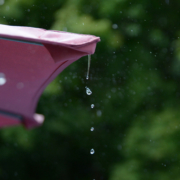To capture rainwater and any excess irrigation inthe soil or rain barrels, it is first necessary to understand what happens when water comes off the roof of buildings and moves across the property.
Where is water moving?
Make a copy of your landscaping site plan, and label it “Water Plan.” It should have the position of the buildings and major landscaping structures. During a rainstorm, watch what happens to water as it comes off the roof of the house and moves through the property.
- Are there any low spots where water pools?
- Does water run entirely off the property anywhere?
- Do any buildings or hard surfaces such as patios appear to be damaged by water? Is the damage caused by rain, by irrigation, or by both?
Note the direction water moves around the property from one area to another, or through multiple areas.
Turn on irrigation systems for three minutes, and make a note about where there is any pooling or runoff.
Assess the downspouts for water volume
Use the following process to figure out how much water comes off any hard surface, whether it is a roof, patio, driveway, or sidewalk.
First, imagine the total roof area of your garage is 20 by 20 feet square, or 400 square feet, and water flows off it in two downspouts.
If half the water goes into each downspout, the roof size for one downspout is half your total area. In this example, that is 200 square feet.
Multiply the square footage for your downspout area by 0.62 to get the gallons of water per inch of rain coming from your downspout. Using our example of 200 square feet, the formula is 200 x 0.62 = 124 gallons.
Once you have this number, you can plan for the resources needed to capture this water runoff for later use using tools such as rain barrels.
This article was inspired by the 71-page Sustainable Landscapes Program guidebook available at SustainableLandscapesSD.org. The Water Authority and its partners also offer other great resources for landscaping upgrades, including free WaterSmart classes at WaterSmartSD.org.




